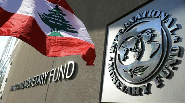
The suspenseful series of "crisis exit plans" is continuing with great success on the government's encrypted channel, maintaining the same theme but varying in style and appellation. Over the past four years, we've had about 10 plans labeled "recovery," "rescue," "restructuring"... But in reality, these plans more closely resembled, in the spirit of the money heist genre, a remake of Casa de Papel, though with less charisma than the Professor.
It all started with Hassan Diab's cabbage leaf, then it continued with other vegetables from the same Brassicaceae family. And it won't end with Saade Chami's latest pickle, which reached maturity just a few days ago.
It would be pointless and premature to delve into the details of this so-called latest plan, which, given the amount of arrows thrown at it from all sides, is likely to be stillborn. Funerals, mourning, bitter exchanges on responsibilities and requiem masses will follow, before a new plan of the same ilk sprouts in the same vegetable patch.
But it would be interesting to extract the common denominators from all these plans. To extract what actually goes wrong, what turns these plans into acts of mass destruction.
1. First, all these plans directly affect the banking sector but don't invite this sector to participate. It simply reads in the press what has been concocted for it and then executes it. Similarly for depositors, a cumbersome caste, considered negligible.
2. Furthermore, in all these plans, the state disregards its debts, whether to holders of Eurobonds, the Central Bank (BDL), banks or others. In other words, it has no intention of paying anything to anyone. A pathological denial of reality because, while it may attempt to defraud local parties (even at the risk of destroying the country's economy), it cannot escape foreign creditors.
In this regard, the State Council has just ruled in favor of banks contesting a 2022 Council of Ministers decision stipulating the elimination of a significant portion of the BDL's commitments to banks.
3. The current government does not acknowledge that the Central Bank is part of the state, for which it is responsible, legally and structurally. The presumed autonomy of the BDL changes nothing in this regard. There's also the Electricité du Liban (EDL), another autonomous body that has swallowed tens of billions of dollars of public money, causing chronic colic for the public supplier and successive concerned ministers.
4. Contrary to what is often argued, it is not on four parties to bear the burden—namely, the state, the BDL, banks and depositors. There are only two parties: on one side, the state, which includes the BDL, and on the other, banks with their depositors (and through them, all of society and businesses).
5. The ongoing attempt to pit banks and depositors against each other, subtly embedded between the lines in all plans, is a deceitful notion as big as a pumpkin, to stay in the vegetable patch. What affects one affects the other, and vice versa. One's prosperity will reflect on the other, and a bank failure will drag deposits into its abyss.
6. The endless rhetoric of having to scrutinize each bank's situation to then decide if it is bankrupt or not is yet another deceitful notion, given the current state of affairs. Why? Because to calculate a bank's assets, you need to know if the Central Bank and the state will repay the amounts owed to it, in what proportion and in what currency. Then decide what value to assign to its real estate or old loans. Then it also depends on the exchange rate to apply to their financial accounts.
7. Also, to figure out the future of the bank, whether it will be able to operate normally again or sink, authorities must first have decided what means the bank will have to generate income, what money it will be allowed to use to grant new loans, which is its vital lucrative activity: the fresh $3.5 billion already deposited? The $9 billion in reserves still in the hands of the BDL? Other amounts possibly recovered from state debt and placements with the BDL?
8. Then, authorities must finally define this famous "deposit recovery fund," a phantom of the opera that is occasionally mentioned—but what is never specified is how this fund will be funded, what amounts are hoped to be raised, and how this sum will be distributed. And this at a time when the bottom-of-the-barrel of low-grade populism emerges each time to declare that "state assets belong to the entire people, not to certain depositors."
In short, with all these plans, especially the latest one ("bank restructuring"), an attempt is being made to sell the bear's skin before killing it, before even buying a rifle, learning to hunt, obtaining a hunting permit, correcting one's myopia so as not to shoot into the crowd. Even before planning how to plunder the money from the sale.
Read more




Comments